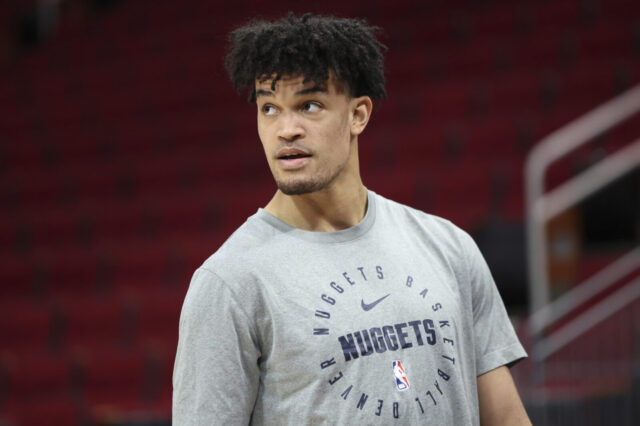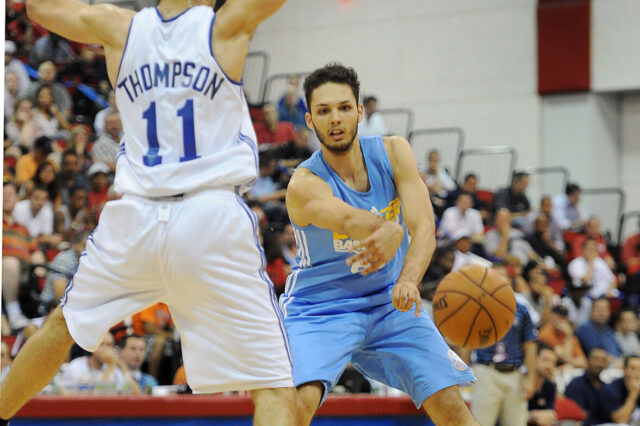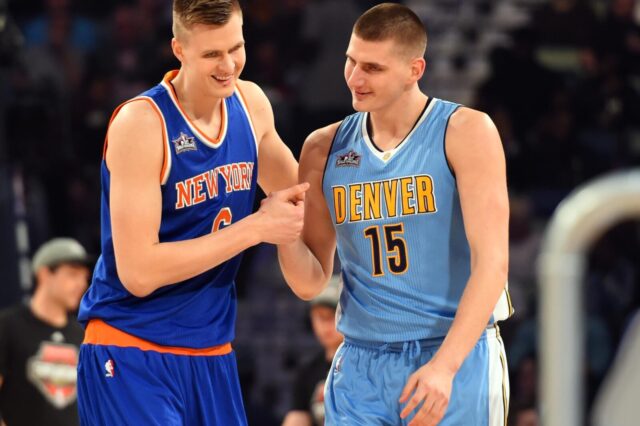It’s almost hard to call yourself a fan of the Denver Nuggets (or at least a fan of Denver Stiffs) if you don’t know that the Nuggets had one of the best offenses in the league after inserting Nikola Jokic back into the starting lineup and benching Jusuf Nurkic.
The Nuggets, under the tutelage of since-departed assistant coach Chris Finch, installed a motion offense centered around the team’s sophomore center and his prodigious ability to share the ball. Since that decision to build around Jokic, the mission statement for the organization has been to find players that can play alongside Jokic to get the most out of the team.
It would seem obvious that the team will look to build their identity next season around Jokic – but what about the changes that have taken place during the offseason? Gone is the talented offensive forward, Danilo Gallinari, and in his place steps his former backup, Wilson Chandler. The Nuggets signed All-Star forward Paul Millsap, a versatile threat from the rim to the perimeter. The team seems poised to give Jamal Murray, Emmanuel Mudiay, and Jameer Nelson an opportunity to compete for the starting point guard role in training camp. A draft day trade brought in Trey Lyles, who could compete with Kenneth Faried, Darrell Arthur, and first round pick Tyler Lydon.
What does it mean to have the offense centered around Jokic?
There are a variety of stats that can be used to back up what was evident during games last season – Nikola Jokic was the focal point on offense. Advanced stats such as usage rate are helpful, and tracking stats courtesy of the NBA such as touches and time of possession are also useful.
| Player | Usage rate | TOP | Touches |
|---|---|---|---|
| Nikola Jokic | 23.4 | 2.2 | 68.3 |
| Jamal Murray | 21.6 | 2.2 | 36.4 |
| Gary Harris | 18.5 | 1.4 | 38.2 |
| Wilson Chandler | 22.1 | 1.8 | 48.5 |
| Paul Millsap | 24.4 | 2.2 | 64.9 |
| Will Barton | 21.1 | 2.5 | 46 |
| Jameer Nelson | 15.7 | 4.4 | 58.1 |
| Emmanuel Mudiay | 22.4 | 4.3 | 58.7 |
| Kenneth Faried | 18.1 | 0.7 | 31.6 |
| Mason Plumlee | 17.9 | 1.3 | 38.4 |
First, I want to explain what these stats mean. Usage rate, according to Basketball Reference, “is an estimate of the percentage of team plays used by a player while he was on the floor.” This number uses field goal attempts, free throw attempts and turnovers for the individual as a part of the team’s total field goal attempts, free throw attempts, and turnovers. These are the easiest ways to track impact plays, because they all make a difference in the game. A player that takes a high volume of shots, free throws, and turns the ball over frequently while playing a lot of minutes would have a high usage rate – see Russell Westbrook, who had a bonkers 41.7% usage rate last season.
For the Nuggets, players like Emmanuel Mudiay can have the second-highest usage rate on the team despite attempting the sixth-most field goal attempts, the fifth-most free throw attempts, and the seventh-most minutes per game because he had the second-most turnovers per game. Traditional stats like rebounds, assists, or advanced stats like time of possession aren’t part of usage rate, and don’t affect that number. It only tracks three outcomes.
Next, time of possession. This should be more obvious – it tracks the seconds a player possesses the ball per game. There are 48 minutes in a regulation game, each team splits possession roughly in half, and anywhere from 5 to 12 players can participate for each team. The NBA shares time of possession in minutes, so Jameer Nelson had 4.4 minutes of possession per game, or 4 minutes and 24 seconds per game.
Finally, touches per game, another obvious stat courtesy of the NBA’s tracking software. This stat measures how many times a player touches the ball – in the back and front court. When a player inbounds the ball, that’s a touch. When a player catches a pass and shoots, that’s a touch. It’s easy to guess which players had the most touches per game last season – Westbrook, Harden, Paul, LeBron, TJ McConnell (wait, seriously??) – and Jokic had the most touches per game for the Nuggets. There were only a few other players to have more touches per game than Jokic and play fewer than 30 minutes per game – McConnell, Rajon Rondo, Elfrid Payton and DeAngelo Russell.
Thus, when fans talk about the offense being “centered” around Nikola Jokic, it doesn’t necessarily have to mean that he has the highest usage rate. It does mean that he should be towards the top in time of possession, but that stat is usually dominated by guards, who have the advantage of bringing the ball up the court time after time throughout the game. It does mean that he should be towards the top in number of touches, because if he’s touching the ball, that means he’s able to make decisions and facilitate plays for the team.
In a totally hypothetical situation, if the Nuggets were to trade for Kevin Durant, they could run the offense through Jokic but he wouldn’t have the highest usage rate on the team, because the Nuggets would want Durant to have the most field goal attempts and free throw attempts. Jokic might not even lead the team in time of possession or touches (having Durant shoot the ball often usually is very effective). Jokic could be the initiator of the offense, but he wouldn’t have to be the finisher of the offense – hopefully that makes sense.
What will happen next season?
The Nuggets lost Gallinari’s 11.9 field goal attempts after they traded him to the Los Angeles Clippers, but they added a player in Millsap that was taking 13.5 field goal attempts per game over the last four years in Atlanta.
In my opinion, the Nuggets will likely try to play Jokic for at least 30 minutes a game, and that will increase his field goal attempts per game as well. Murray’s attempts will likely increase if he wins the starting point guard role, but the shot distribution should stay relatively the same between the three point guards from last season (27 per game for Mudiay, Murray, and Nelson).
I’m going to predict that Millsap is able to carry the usage responsibilities that Gallinari had last season. That will mean that Jokic will be the “center of the offense,” with Millsap getting the second most opportunities to be the focal point of the offense. The Nuggets guards will continue to get open shot attempts on the perimeter and at the rim in the motion offense they installed last season, while the wings get isolation plays as well as opportunities off screens and in transition.
What could change that?
Nothing – the Nuggets will likely be rumored in trade discussions until the trade deadline for players like Eric Bledsoe, Kyrie Irving…any star, basically. The offense will likely continue to run through Jokic, but the players finishing possessions could change. Whether the player putting the ball in the hoop is Jamal Murray or Goran Dragic (note – there are zero Dragic rumors, I’m just naming a random guard) the offense will be run by Jokic. I don’t think the Nuggets will change their offense for anyone (outside of LeBron James and a few other players) after seeing how effective things were last season.
In my opinion, Jokic will be at his best scoring about 20 points per game, getting 10 to 12 rebounds per game, and getting about six assists per game. If the Nuggets need him to score, his efficiency could worsen, and it may be a side effect of the rest of his teammates not doing enough to complement him on offense.
The Nuggets had six players average double figures in scoring last season (with Jamal Murray at 9.9 points per game), and that can be very difficult for teams to defend in the regular season. I think it would be wise to try to duplicate that again, with Jokic, Millsap, Murray, Harris, Chandler and Barton averaging double figures in 2017-18. If players like Kenneth Faried and Juancho Hernangomez can average between 8 to 10 points per game, that makes the team that much better.
If the Nuggets do make a trade for a star player, please be patient and give the team a chance to prove that they know what they’re doing. NBA players are not imbeciles, and are quite skilled at what they do. We can’t expect young players to develop into better versions of themselves while also expecting older players to not adapt to a new situation. Playing basketball is their job, and many of them are very skilled at their profession.
This content is no longer available.


